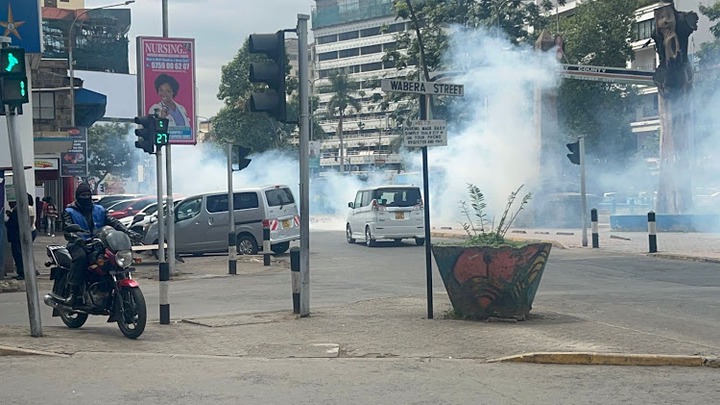Nane Protests in Kenya
Nane Protests: In the early hours of Thursday, August 8th, the much-anticipated Nane Nane protests began to take shape in Nairobi, Kenya’s capital. Demonstrators, many of them young Kenyans, gathered along Tom Mboya Street in the city’s Central Business District (CBD) to voice their grievances against the government.
However, the name protests were swiftly disrupted by police, who had already tightened security in anticipation of the demonstrations.
The police, some of whom were dressed in civilian clothing to blend in with the crowd, moved quickly to arrest several nane nane protesters.
The arrested individuals were bundled into nearby police vehicles, ready for rapid deployment. This move by the police was a clear indication of the government’s determination to maintain order and prevent any escalation of the protests into violence or chaos.
Heavy Deployment of Anti-Riot Police Across Nairobi
The arrests were just the beginning of a broader, more extensive security operation that saw the deployment of anti-riot police throughout Nairobi and other potential hotspots across the country. The acting Inspector General of Police, Gilbert Masengeli, had earlier assured the public that the police force was fully prepared to handle the situation and maintain peace and order throughout the nation. However, the sheer scale of the security deployment, including officers in full riot gear and the presence of armored vehicles, suggested that the authorities were expecting the possibility of significant unrest.
This heavy police presence was not limited to the capital. Reports from various parts of Kenya indicated that similar measures were being taken in other cities and towns, particularly in areas known for their strong support of opposition politics. The government’s approach was clearly aimed at preventing the kind of widespread disruption that had been seen in previous protests.
Kenyans’ Right to Protest: Balancing Liberty and Law
Inspector General Masengeli emphasized respecting the law while exercising the right to protest. He acknowledged that every Kenyan has the constitutional right to peacefully demonstrate, picket, and assemble. However, he also made it clear that these rights must be exercised within the confines of the law. “Where the privilege of one ends is where the other starts,” he stated, highlighting the delicate balance between individual freedoms and maintaining public order.
Masengeli also reiterated that the police would not hesitate to take firm action against any individuals who sought to exploit the protests for criminal activities. This warning was particularly directed at those who might use the demonstrations as an opportunity to incite violence, vandalize property, or engage in looting. “We are governed by the Rome statute and the Kenyan Constitution,” he said, underscoring the legal framework within which the police operate and the need for all citizens to abide by the rule of law.
Gen Z Leads the Charge: Mobilizing for Nane Nane Protests
The Nane Nane protests have been largely driven by Kenya’s younger generation, often referred to as Gen Z. This group, characterized by their tech-savviness and strong presence on social media, has been at the forefront of organizing and mobilizing for the demonstrations. Over the past few weeks, platforms such as X, WhatsApp, TikTok, and Instagram have been abuzz with calls to action as young Kenyans rallied their peers to join the protests.
This is the third consecutive month that Gen Z has taken to the streets in anti-government protests. Their demands are varied but revolve around issues such as unemployment, high cost of living, and perceived government corruption. The protests have also been fueled by dissatisfaction with the current political leadership, with many young people feeling that their voices are not being heard in the corridors of power.
One of the most popular slogans circulating online in the lead-up to the protests was “This is our destiny; August 8, 2024. Don’t be left behind.” The phrase captures the determination of Kenya’s youth to take control of their future and hold the government accountable for its actions. Another widely shared poster, under the hashtag #OccupyStateHouse, called for an end to police brutality against protesters and demanded that the government respect the rights of all Kenyans, not just the interests of politicians.
Political Tensions: Ruto and Raila’s Alliance Faces a Test
The Nane Nane demonstrations are not just a test of the government’s ability to maintain order; they also represent a significant challenge for Kenya’s political leadership, particularly President William Ruto and opposition leader Raila Odinga. Over the past few months, the two leaders have struck a political deal aimed at defusing tensions and preventing the country from descending into chaos. However, the Nane Nane protests suggest that this alliance may be more fragile than it appears.
Observers have noted that the alliance between Ruto and Raila has divided opinion, particularly among the youth. Some see the deal as a necessary step to stabilize the country, while others view it as a betrayal of the opposition’s role in holding the government accountable.
This division has been particularly evident in the lead-up to the Nane Nane protests, with some young people expressing frustration that the deal has not led to tangible improvements in their lives.
In previous protests, areas considered strongholds of both Ruto and Raila witnessed significant unrest. This included Ruto’s home turf in the Rift Valley, as well as key regions in Raila’s political base, such as Kisumu, Siaya, and Mombasa. The fact that protests have continued in these areas despite the political deal suggests that dissatisfaction runs deep and is not easily quelled by top-level agreements.
Calls for Restraint: Focus on Governance Over Protests
As the Nane Nane protests approached, there were calls from various quarters for restraint and a shift in focus towards governance. Makadara MP George Aladwa, who is also the ODM Nairobi County Chairman, was one of the prominent voices urging the protest organizers to call off the demonstrations.
Aladwa argued that President Ruto had made significant concessions, including dissolving the Cabinet and forming a more inclusive government, and that he should be given time to implement these changes.
“We ask Kenyans to allow the Cabinet to be sworn in and give the President time to implement the changes,” Aladwa said, appealing to the public to consider the potential long-term benefits of the government’s new approach. He emphasized that continuous nane protests could lead to further instability, ultimately harming the country’s economy and the livelihoods of ordinary citizens.
Aladwa’s call for restraint was echoed by other ODM leaders, who highlighted the importance of maintaining peace and stability during this critical period. They argued that while the right to nane protests is enshrined in the Constitution, it should not come at the expense of national unity and development. The leaders also expressed concern that the ongoing nane protests could be hijacked by criminal elements, leading to violence and destruction that would only set the country back.
Conclusion: The Future of Kenya’s Political Landscape
Kenya stands at a crossroads as the Nane Nane protests continue to unfold. The outcome of these demonstrations could have far-reaching implications for the country’s political landscape and social and economic stability. The actions of the police, the response of the government, and the resolve of the protesters will all play a crucial role in shaping the future of Kenya.
For those following the developments, it is clear that the situation is dynamic and fluid, with the potential for significant change in the coming days and weeks. As always, it is important to stay informed and engaged with reliable sources of Kenyan news to understand the full context of these events and the impact of the nane-nane protests on the nation.








